Prediction of Green Solvent Applicability in Cultural Heritage Using Hansen Solubility Parameters, Cremonesi Method and Integrated Toxicity Index
Abstract
1. Introduction
1.1. Green Solvent
1.2. Potential Use of Green Solvents for the Solubilization of Materials in Cultural Heritage
2. Materials and Methods
2.1. Green Solvents Dataset
- Fractional parameters developed by Teas in 1968 [101]:
- fd = δd/(δd + δp + δh);
- fp = δp/(δd + δp + δh);
- fh = δh/(δd + δp + δh).
- Final relationship between fractional parameters:fd + fp + fh = 1
2.2. Toxicity Parameters
- GHS Hazard Statements (H-statements): Indicators of both acute and chronic toxicity risks, weighted according to severity.
- Precautionary Statements (P-statements): Recommendations for handling, exposure control, and risk mitigation.
- LD50 Data (if available): The lethal dose required to kill 50% of a test population, used as a standard measure of acute toxicity.
- Derived No-Effect Levels (DNELs) and Occupational Exposure Limits (OELs): Regulatory benchmarks for safe exposure limits, used to validate and adjust hazard severity scores when available.
2.2.1. Hazard Statement Weights (H-Values)
- Quantitative Toxicity Measures. LD50 values serve as reference points for adjusting acute toxicity weights, ensuring consistency with traditional toxicity thresholds.
- GHS Classification and Toxicity Thresholds. Higher weights are assigned to substances with severe acute toxicity (Category 1: H300, H310, H330) and those causing significant long-term health effects (e.g., organ-specific damage H370, H372). Lower weights are applied to substances with moderate or localized toxicity, such as mild skin irritants (H315).
- Toxicological Benchmarks and Health Risks. Weights for systemic toxicity (STOT), reproductive toxicity, and carcinogenicity were determined by the literature. Carcinogens classified as Category 1A or 1B (H350, H340) are assigned the highest weight (10), reflecting their severe long-term health impacts.
2.2.2. Precautionary Statement Weights (p-Values)
- Regulatory Guidelines and Hazard Control Standards.
- Criticality of Exposure Prevention. Higher weights are assigned to P-statements that require immediate medical attention or the use of personal protective equipment (PPE).
- Impact on Safety and Exposure Control. P-statements associated with life-threatening exposure risks receive higher weights, whereas handling and disposal precautions receive lower weights.
2.2.3. Uncertainty Adjustment
- Uf = 1.0 → When full toxicological data is available.
- Uf = 1.5 → When LD50 values are missing, requiring estimation from structurally similar substances.
- Uf = 2.0 → When only partial H-statement or P-statement data is available, necessitating conservative extrapolation.
2.2.4. Final ITI Calculation
- Hi = Individual hazard statement
- Pj = Precautionary statement
- WHi, WPj = Adjusted weights based on DNELs/OELs
- Uf = Uncertainty factor
2.3. Cremonesi Re-Style with Hansen Style
2.4. Replacing Traditional Solvents in Restoration Applications
2.5. AI Validation Section
3. Results
3.1. Green Solvents Dataset
- Ionic Liquids demonstrated superior compatibility with polar mixtures, particularly water-ethanol systems and essential oils. This can be attributed to their relatively high δP and δH values, which enhance their ability to solubilize highly polar and hydrogen-bonding solutes.
- FAME-family solvents exhibited remarkable versatility in handling hydrophobic compounds, such as fatty acids and plant oils. This behavior is consistent with their high δD and low δP/δH values, indicating a dominance of dispersion interactions and limited polar or hydrogen bonding capabilities.
- Deep Eutectic Solvent (DES) systems exhibit a strong solvation power, which is linked to moderate δD, high δP, and exceptionally high δH values, which enable them to engage in extensive hydrogen bonding.
3.2. Toxicity Parameters of Green Solvents
3.3. Cremonesi Restyle with Hansen Style
- Volume of the Principal Sphere: 5062.36 units
- Total Volume of Local Spheres: 971.97 units
- Coverage Ratio: 0.192 (19.2%)
- Five binary mixtures of ligroin-acetone (L100A0, L75A25, L50A50, L25A75, L0A100);
- Four binary mixtures of acetone-ethanol (A75E25, A50E50, A25E75, A0E100);
- Four ternary mixtures (L50A25E25, L25A50E25, L25A25E50, L33A33E33)
3.4. Replacing Traditional Solvents in Restoration Applications
4. Discussion
5. Conclusions
Supplementary Materials
Author Contributions
Funding
Institutional Review Board Statement
Informed Consent Statement
Data Availability Statement
Acknowledgments
Conflicts of Interest
Abbreviations
| SDS | Safety Data Sheets |
| RED | Relative Energy Difference |
| ITI | Integrated Toxicity Index |
| HSP | Hansen Solubility Parameters |
| FAMEs | Fatty Acids methyl esters |
| ILs | Ionic liquids |
| NADES | Natural deep eutectic solvents |
| FAEEs | Fatty acid ethyl esters |
| SAC | Solvent-aided crystallization |
References
- Ormsby, B.; Keefe, M.; Phenix, A.; von Aderkas, E.; Learner, T.; Tucker, C.; Kozak, C. Mineral Spirits-Based Microemulsions: A Novel Cleaning System for Painted Surfaces. J. Am. Inst. Conserv. 2016, 55, 12–31. [Google Scholar] [CrossRef]
- Casini, A.; Chelazzi, D.; Baglioni, P. Advanced methodologies for the cleaning of works of art. Sci. China Technol. Sci. 2023, 66, 2162–2182. [Google Scholar] [CrossRef]
- Romero-Noguera, J.; Pérez-Villares, N.; Bolívar-Galiano, F.; Bailón-Moreno, R. Response Surface Model Applied to Fine Arts: The Case of the Restoration of Paintings. In Response Surface Methodology—Research Advances and Applications; IntechOpen: London, UK, 2023. [Google Scholar] [CrossRef]
- Filly, A.; Fabiano-Tixier, A.S.; Fernandez, X.; Chemat, F. Alternative solvents for extraction of food aromas. Experimental and COSMO-RS study. LWT-Food Sci. Technol. 2015, 61, 33–40. [Google Scholar] [CrossRef]
- Zhang, Q.; De Oliveira Vigier, K.; Royer, S.; Jérôme, F. Deep eutectic solvents: Syntheses, properties and applications. Chem. Soc. Rev. 2012, 41, 7108–7146. [Google Scholar] [CrossRef] [PubMed]
- Shah, P.; Parikh, S.; Shah, M.; Dharaskar, S. A holistic review on application of green solvents and replacement study for conventional solvents. Biomass Convers. Biorefinery 2022, 12, 1985–1999. [Google Scholar] [CrossRef]
- Nanda, B.; Sailaja, M.; Mohapatra, P.; Pradhan, R.; Nanda, B.B. Green solvents: A suitable alternative for sustainable chemistry. Mater. Today Proc. 2021, 47, 1234–1240. [Google Scholar] [CrossRef]
- Scott, R.S.; Frame, S.R.; Ross, P.E.; Loveless, S.E.; Kennedy, G.L. Inhalation Toxicity of 1,3-Propanediol in the Rat. Inhal. Toxicol. 2005, 17, 487–493. [Google Scholar] [CrossRef]
- Mangotra, A.; Singh, S.K. Volatile organic compounds: A threat to the environment and health hazards to living organisms—A review. J. Biotechnol. 2024, 382, 51–69. [Google Scholar] [CrossRef]
- Warner, J.C.; Cannon, A.S.; Dye, K.M. Green chemistry. Environ. Impact Assess. Rev. 2004, 24, 775–799. [Google Scholar] [CrossRef]
- Calvo-Flores, F.G.; Monteagudo-Arrebola, M.J.; Dobado, J.A.; Isac-García, J. Green and Bio-Based Solvents. Top. Curr. Chem. 2018, 376, 18. [Google Scholar] [CrossRef]
- Mallakpour, S.; Rafiee, Z. Green Solvents Fundamental and Industrial Applications. In Green Solvents I; Springer: Dordrecht, The Netherlands, 2012; pp. 1–66. [Google Scholar] [CrossRef]
- Singh, P.K.; Singh, N.; Singh, A.P.; Bhardwaj, P.; Sachan, K.; Singh, S. Mixed Solvency Concept to Replace Harmful Organic Solvent: Recent Trends and Future Challenges in Formulation Development. Comb. Chem. High Throughput Screen. 2025, 28, 226–238. [Google Scholar] [CrossRef] [PubMed]
- Pistikopoulos, E.; Stefanis, S. Optimal solvent design for environmental impact minimization. Comput. Chem. Eng. 1998, 22, 717–733. [Google Scholar] [CrossRef]
- Lakshmipraba, J.; Prabhu, R.N. Deep Eutectic Solvents, Bio-Based Solvents, and Surfactant for Green Sample Pretreatment and Determination. In Green Chemical Analysis and Sample Preparations; Springer International Publishing: Cham, Switzerland, 2022; pp. 353–378. [Google Scholar] [CrossRef]
- de Marco, B.A.; Rechelo, B.S.; Tótoli, E.G.; Kogawa, A.C.; Salgado, H.R.N. Evolution of green chemistry and its multidimensional impacts: A review. Saudi Pharm. J. 2019, 27, 1–8. [Google Scholar] [CrossRef]
- Liu, X.; Yu, D.; Luo, H.; Li, C. Green Solvents for Lipid Extraction from Microalgae to Produce Biodiesel. Front. Chem. 2022, 10, 884274. [Google Scholar] [CrossRef]
- Melchiorre, C.; Melchiorre, M.; Marra, M.; Rizzo, E.; Fatigati, G.; Rossi, P.; Cerruti, P.; Improta, I.; Amoresano, A.; Marino, G.; et al. Green solvents and restoration: Application of biomass-derived solvents in cleaning procedures. J. Cult. Herit. 2023, 62, 3–12. [Google Scholar] [CrossRef]
- Márquez-Román, V.A.; Mena-Cervantes, V.Y.; Hernández-Altamirano, R.; Pineda-Flores, G.; González-Espinosa, M.A. Fatty Acid Methyl Esters from Jatropha Curcas L. Seeds as a Green Solvent for Remediation of Soil Contaminated with Anthracene. In Recent Advances in Environmental Science from the Euro-Mediterranean and Surrounding Regions; Springer: Cham, Switzerland, 2024; pp. 205–208. [Google Scholar] [CrossRef]
- Salehpour, S.; Dubé, M.A. Biodiesel: A green polymerization solvent. Green Chem. 2008, 10, 321–326. [Google Scholar] [CrossRef][Green Version]
- Osman, W.N.A.W.; Badrol, N.A.I.; Samsuri, S. Biodiesel Purification by Solvent-Aided Crystallization Using 2-Methyltetrahydrofuran. Molecules 2023, 28, 1512. [Google Scholar] [CrossRef]
- Zaratti, C.; Marinelli, L.; Colasanti, I.A.; Barbaccia, F.I.; Aureli, H.; Prestileo, F.; de Caro, T.; La Russa, M.F.; Macchia, A. Evaluation of Fatty Acid Methyl Esters (FAME) as a Green Alternative to Common Solvents in Conservation Treatments. Appl. Sci. 2024, 14, 1970. [Google Scholar] [CrossRef]
- Purkait, A.; Hazra, D.K. Biodiesel as a carrier for pesticide formulations: A green chemistry approach. Int. J. Pest Manag. 2020, 66, 341–350. [Google Scholar] [CrossRef]
- Planer, S.; Jana, A.; Grela, K. Ethyl Lactate: A Green Solvent for Olefin Metathesis. ChemSusChem 2019, 12, 4655–4661. [Google Scholar] [CrossRef]
- Pereira, C.S.M.; Silva, V.M.T.M.; Rodrigues, A.E. Ethyl lactate as a solvent: Properties, applications and production processes—A review. Green Chem. 2011, 13, 2658–2671. [Google Scholar] [CrossRef]
- Nikles, S.M.; Piao, M.; Lane, A.M.; Nikles, D.E. Ethyl lactate: A green solvent for magnetic tape coating. Green Chem. 2001, 3, 109–113. [Google Scholar] [CrossRef]
- Dolzhenko, A.V. Ethyl lactate and its aqueous solutions as sustainable media for organic synthesis. Sustain. Chem. Pharm. 2020, 18, 100322. [Google Scholar] [CrossRef]
- Abdullah, M.A.; Hussein, H.A.; Alshajrawi, O.M.S. Ethyl lactate as a green solvent in the pharmaceutical industry. In Green Sustainable Process for Chemical and Environmental Engineering and Science; Elsevier: Amsterdam, The Netherlands, 2021; pp. 185–194. [Google Scholar] [CrossRef]
- Hu, J.; Du, Z.; Tang, Z.; Min, E. Study on the Solvent Power of a New Green Solvent: Biodiesel. Ind. Eng. Chem. Res. 2004, 43, 7928–7931. [Google Scholar] [CrossRef]
- Mehdi, H.; Fábos, V.; Tuba, R.; Bodor, A.; Mika, L.T.; Horváth, I.T. Integration of Homogeneous and Heterogeneous Catalytic Processes for a Multi-step Conversion of Biomass: From Sucrose to Levulinic Acid, γ-Valerolactone, 1,4-Pentanediol, 2-Methyl-tetrahydrofuran, and Alkanes. Top. Catal. 2008, 48, 49–54. [Google Scholar] [CrossRef]
- Veith, C.; Diot-Néant, F.; Miller, S.A.; Allais, F. Synthesis and polymerization of bio-based acrylates: A review. Polym. Chem. 2020, 11, 7452–7470. [Google Scholar] [CrossRef]
- Smoleń, M.; Kędziorek, M.; Grela, K. 2-Methyltetrahydrofuran: Sustainable solvent for ruthenium-catalyzed olefin metathesis. Catal. Commun. 2014, 44, 80–84. [Google Scholar] [CrossRef]
- Slater, C.S.; Savelski, M.J.; Hitchcock, D.; Cavanagh, E.J. Environmental analysis of the life cycle emissions of 2-methyl tetrahydrofuran solvent manufactured from renewable resources. J. Environ. Sci. Health Part A 2016, 51, 487–494. [Google Scholar] [CrossRef]
- Pace, V.; Hoyos, P.; Castoldi, L.; de María, P.D.; Alcántara, A.R. 2-Methyltetrahydrofuran (2-MeTHF): A Biomass-Derived Solvent with Broad Application in Organic Chemistry. ChemSusChem 2012, 5, 1369–1379. [Google Scholar] [CrossRef]
- Rapinel, V.; Claux, O.; Abert-Vian, M.; McAlinden, C.; Bartier, M.; Patouillard, N.; Jacques, L.; Chemat, F. 2-Methyloxolane (2-MeOx) as Sustainable Lipophilic Solvent to Substitute Hexane for Green Extraction of Natural Products. Properties, Applications, and Perspectives. Molecules 2020, 25, 3417. [Google Scholar] [CrossRef]
- Zelner, I.; Matlow, J.N.; Natekar, A.; Koren, G. Synthesis of fatty acid ethyl esters in mammalian tissues after ethanol exposure: A systematic review of the literature. Drug Metab. Rev. 2013, 45, 277–299. [Google Scholar] [CrossRef]
- Winterton, N. The green solvent: A critical perspective. Clean Technol. Environ. Policy 2021, 23, 2499–2522. [Google Scholar] [CrossRef]
- Bhatia, S.C. Biofuels: A review. In Advanced Renewable Energy Systems; Elsevier: Amsterdam, The Netherlands, 2014; pp. 403–425. [Google Scholar] [CrossRef]
- Hikmawanti, N.P.E.; Ramadon, D.; Jantan, I.; Mun’im, A. Natural Deep Eutectic Solvents (NADES): Phytochemical Extraction Performance Enhancer for Pharmaceutical and Nutraceutical Product Development. Plants 2021, 10, 2091. [Google Scholar] [CrossRef] [PubMed]
- Dias, M.C.G.C.; Farias, F.O.; Gaioto, R.C.; Kaspchak, E.; da Costa, M.C.; Igarashi-Mafra, L.; Mafra, M.R. Thermophysical characterization of deep eutectic solvents composed by D-sorbitol, xylitol or D(+)xylose as hydrogen bond donors. J. Mol. Liq. 2022, 354, 118801. [Google Scholar] [CrossRef]
- Santana-Mayor, Á.; Rodríguez-Ramos, R.; Herrera-Herrera, A.V.; Socas-Rodríguez, B.; Rodríguez-Delgado, M.Á. Deep eutectic solvents. The new generation of green solvents in analytical chemistry. TrAC Trends Anal. Chem. 2021, 134, 116108. [Google Scholar] [CrossRef]
- Hooshmand, S.E.; Afshari, R.; Ramón, D.J.; Varma, R.S. Deep eutectic solvents: Cutting-edge applications in cross-coupling reactions. Green Chem. 2020, 22, 3668–3692. [Google Scholar] [CrossRef]
- Hansen, B.B.; Spittle, S.; Chen, B.; Poe, D.; Zhang, Y.; Klein, J.M.; Horton, A.; Adhikari, L.; Zelovich, T.; Doherty, B.W.; et al. Deep Eutectic Solvents: A Review of Fundamentals and Applications. Chem. Rev. 2020, 121, 1232–1285. [Google Scholar] [CrossRef]
- Ristivojević, P.; Ristivojević, M.K.; Stanković, D.; Cvijetić, I. Advances in Extracting Bioactive Compounds from Food and Agricultural Waste and By-Products Using Natural Deep Eutectic Solvents: A Circular Economy Perspective. Molecules 2024, 29, 4717. [Google Scholar] [CrossRef]
- Wang, H.; Chen, J.; Pei, Z.; Fang, Z.; Yang, S.; Li, H. Bio-based deep eutectic solvent of enhanced lignin solubility for wheat straw fractionation and full-component utilization. Ind. Crops Prod. 2025, 223, 120054. [Google Scholar] [CrossRef]
- Breil, C.; Meullemiestre, A.; Vian, M.; Chemat, F. Bio-Based Solvents for Green Extraction of Lipids from Oleaginous Yeast Biomass for Sustainable Aviation Biofuel. Molecules 2016, 21, 196. [Google Scholar] [CrossRef]
- Jin, S.; Byrne, F.; McElroy, C.R.; Sherwood, J.; Clark, J.H.; Hunt, A.J. Challenges in the development of bio-based solvents: A case study on methyl(2,2-dimethyl-1,3-dioxolan-4-yl)methyl carbonate as an alternative aprotic solvent. Faraday Discuss. 2017, 202, 157–173. [Google Scholar] [CrossRef] [PubMed]
- Kaiser, C.S.; Römpp, H.; Schmidt, P.C. Pharmaceutical applications of supercritical carbon dioxide. Pharmazie 2001, 56, 907–926. [Google Scholar]
- Soren, S.; Sahoo, T.; Panda, J.; Senapati, D.K.; Sahu, J.R.; Rath, C.K.; Sahu, R. Carbon Dioxide-Based Green Solvents; Springer: Cham, Switzerland, 2022; pp. 323–333. [Google Scholar]
- Wu, T.; Han, B. Supercritical Carbon Dioxide (CO2) as Green Solvent. In Green Chemistry and Chemical Engineering; Springer: New York, NY, USA, 2019; pp. 173–197. [Google Scholar] [CrossRef]
- Besharati, Z.; Hashemi, S.H. Prediction of CO2 solubility in aqueous and organic solvent systems through machine learning techniques. Model. Earth Syst. Environ. 2024, 11, 4. [Google Scholar] [CrossRef]
- Patil, C.M.; Borse, A.U.; Meshram, J.S. Ionic liquid: Green solvent for the synthesis of cellulose/guar gum/PVA biocomposite. Green Mater. 2018, 6, 23–29. [Google Scholar] [CrossRef]
- Ceres, G.; Conte, V.; Mirruzzo, V.; Kolar, J.; Strlič, M. Imidazolium-Based Ionic Liquids for the Efficient Treatment of Iron Gall Inked Papers. ChemSusChem 2008, 1, 921–926. [Google Scholar] [CrossRef]
- Triolo, A.; Celso, F.L.; Perez, J.; Russina, O. Solubility and solvation features of native cyclodextrins in 1-ethyl-3-methylimidazolium acetate. Carbohydr. Polym. 2022, 291, 119622. [Google Scholar] [CrossRef]
- Lopes, A.M.d.C.; João, K.G.; Morais, A.R.C.; Bogel-Łukasik, E.; Bogel-Łukasik, R. Ionic liquids as a tool for lignocellulosic biomass fractionation. Sustain. Chem. Process. 2013, 1, 3. [Google Scholar] [CrossRef]
- New, E.K.; Tnah, S.K.; Voon, K.S.; Yong, K.J.; Procentese, A.; Shak, K.P.Y.; Subramonian, W.; Cheng, C.K.; Wu, T.Y. The application of green solvent in a biorefinery using lignocellulosic biomass as a feedstock. J. Environ. Manag. 2022, 307, 114385. [Google Scholar] [CrossRef]
- Belesov, A.V.; Mazur, D.M.; Faleva, A.V.; Varsegov, I.S.; Pikovskoi, I.I.; Ulyanovskii, N.V.; Kosyakov, D.S. 1-Butyl-3-methylimidazolium-Based Ionic Liquid in Biomass Fractionation—Green Solvent or Active Reagent Toward Lignin Compounds? Int. J. Mol. Sci. 2024, 25, 12623. [Google Scholar] [CrossRef]
- Mallakpour, S.; Dinari, M. Ionic Liquids as Green Solvents: Progress and Prospects. In Green Solvents II; Springer: Dordrecht, The Netherlands, 2012; pp. 1–32. [Google Scholar] [CrossRef]
- Thamaraiselvan, C.; Wickramasinghe, R. Recent progress on sustainable membrane manufacturing with green solvents and biopolymers. Curr. Opin. Chem. Eng. 2025, 47, 101092. [Google Scholar] [CrossRef]
- Corcoran, G.; Ray, S. Benzyl Alcohol. In Encyclopedia of Toxicology; Elsevier: Amsterdam, The Netherlands, 2014; pp. 429–432. [Google Scholar] [CrossRef]
- Moity, L.; Benazzouz, A.; Molinier, V.; Nardello-Rataj, V.; Elmkaddem, M.K.; de Caro, P.; Thiébaud-Roux, S.; Gerbaud, V.; Marion, P.; Aubry, J.-M. Glycerol acetals and ketals as bio-based solvents: Positioning in Hansen and COSMO-RS spaces, volatility and stability towards hydrolysis and autoxidation. Green Chem. 2015, 17, 1779–1792. [Google Scholar] [CrossRef]
- Yu, L.; Lin, C.; Liao, C.; Zeng, X.; Chen, X.; Zhu, Z.; Huang, Y.; Li, Y.; Chen, L. Green chemistry: Efficient acetalization of aldehydes with alcohols using the acid red 52 photocatalyst. Environ. Chem. Lett. 2020, 18, 1353–1359. [Google Scholar] [CrossRef]
- Kob, N.E. Chapter 17—Clean Solvents. In Dibasic Ester: A Low Risk, Green Organic Solvent Alternative; ACS Symposium Series; American Chemical Society: Washington, DC, USA, 2002; Volume 819, pp. 238–253. [Google Scholar] [CrossRef]
- Nikitas, N.F.; Triandafillidi, I.; Kokotos, C.G. Photo-organocatalytic synthesis of acetals from aldehydes. Green Chem. 2019, 21, 669–674. [Google Scholar] [CrossRef]
- Macchia, A.; Zaratti, C.; Biribicchi, C.; Colasanti, I.A.; Barbaccia, F.I.; Favero, G. Evaluation of Green Solvents’ Applicability for Chromatic Reintegration of Polychrome Artworks. Heritage 2023, 6, 3353–3364. [Google Scholar] [CrossRef]
- Macchia, A.; Rivaroli, L.; Gianfreda, B. The GREEN RESCUE: A ‘green’ experimentation to clean old varnishes on oil paintings. Nat. Prod. Res. 2019, 35, 2335–2345. [Google Scholar] [CrossRef]
- Byrne, F.P.; Jin, S.; Paggiola, G.; Petchey, T.H.M.; Clark, J.H.; Farmer, T.J.; Hunt, A.J.; McElroy, C.R.; Sherwood, J. Tools and techniques for solvent selection: Green solvent selection guides. Sustain. Chem. Process. 2016, 4, 7. [Google Scholar] [CrossRef]
- Granato, A.V.; Santos, A.G.; dos Santos, E.N. p-Cymene as Solvent for Olefin Metathesis: Matching Efficiency and Sustainability. ChemSusChem 2017, 10, 1832–1837. [Google Scholar] [CrossRef]
- Virot, M.; Tomao, V.; Ginies, C.; Chemat, F. Total Lipid Extraction of Food Using d-Limonene as an Alternative to n-Hexane. Chromatographia 2008, 68, 311–313. [Google Scholar] [CrossRef]
- Abdo, D.M.; Mangialardi, T.; Medici, F.; Piga, L. D-Limonene as a Promising Green Solvent for the Detachment of End-of-Life Photovoltaic Solar Panels under Sonication. Processes 2023, 11, 1848. [Google Scholar] [CrossRef]
- Pyo, S.-H.; Park, J.H.; Chang, T.-S.; Hatti-Kaul, R. Dimethyl carbonate as a green chemical. Curr. Opin. Green Sustain. Chem. 2017, 5, 61–66. [Google Scholar] [CrossRef]
- Rivetti, F. The role of dimethylcarbonate in the replacement of hazardous chemicals. C. R. Acad. Sci.-Ser. IIC-Chem. 2000, 3, 497–503. [Google Scholar] [CrossRef]
- Tanzi, C.D.; Vian, M.A.; Ginies, C.; Elmaataoui, M.; Chemat, F. Terpenes as Green Solvents for Extraction of Oil from Microalgae. Molecules 2012, 17, 8196–8205. [Google Scholar] [CrossRef] [PubMed]
- Jordan, A.; Hall, C.G.J.; Thorp, L.R.; Sneddon, H.F. Replacement of Less-Preferred Dipolar Aprotic and Ethereal Solvents in Synthetic Organic Chemistry with More Sustainable Alternatives. Chem. Rev. 2022, 122, 6749–6794. [Google Scholar] [CrossRef]
- Qiao, W.; Zhang, R.; Wen, Y.; Wang, X.; Wang, Z.; Tang, G.; Liu, M.; Kang, H.; Said, Z.; Hwang, J.-Y.; et al. Green solvents in battery recycling: Status and challenges. J. Mater. Chem. A 2024, 12, 11235–11265. [Google Scholar] [CrossRef]
- Signorini, E. Surface Cleaning of Paintings and Polychrome Objects in Italy: The Last 15 Years. 2013. Available online: https://api.semanticscholar.org/CorpusID:145025739 (accessed on 12 December 2024).
- Phenix, A.; Wolbers, R.C.; Townsend, J.; Zumbühl, S.; Bartoletti, A.; Lee, J.; Ormsby, B. Removal of varnish: Organic solvents as cleaning agents. In Conservation of Easel Paintings; Taylor & Francis Ltd.; Routledge: London, UK, 2020; pp. 549–573. [Google Scholar] [CrossRef]
- Baij, L.; Hermans, J.; Ormsby, B.; Noble, P.; Iedema, P.; Keune, K. A review of solvent action on oil paint. Heritage Sci. 2020, 8, 43. [Google Scholar] [CrossRef]
- Feller, R.L. On Picture Varnishes and Their Solvents; Feller, R.L., Stolow, N., Jones, E.H., Eds.; National Gallery of Art: Washington, DC, USA, 1985. [Google Scholar]
- Baglioni, P.; Chelazzi, D.; Giorgi, R. Cleaning of Wall Paintings and Stones. In Nanotechnologies in the Conservation of Cultural Heritage; Springer: Dordrecht, The Netherlands, 2015; pp. 61–82. [Google Scholar] [CrossRef]
- Renda, V.; Saladino, M.L.; Caramanna, S.; Chirco, G.; Castello, A.F.; Conti, C.; Marco, A.; SALI, D.; Caponetti, E. Investigation on a low environmental impact solvent mixture applied to a wooden painted slab. Int. J. Conserv. Sci. 2016, 7, 789. [Google Scholar]
- L_Uso_dei_Solventi_Organici_Nella_Pulitura di Opera Policrome; Paolo Cremonesi, il Prato Casa Editrice: Padova, Italy, January 2004.
- Balliana, E.; Ricci, G.; Pesce, C.; Zendri, E. International Journal of Conservation Science Assessing the Value of Green Conservation for Cultural Heritage: Positive and Critical Aspects of Already Available Methodologies. Available online: www.ijcs.uaic.ro (accessed on 17 November 2024).
- Müller, L.; Henniges, U.; Schultz, J.; Wöllner, A.; Zumbühl, S.; Brückle, I. Pressure-sensitive Tape Removal in Paper Conservation: A Review. J. Pap. Conserv. 2022, 22, 59–75. [Google Scholar] [CrossRef]
- Sawicki, M.; Rouse, E.; Bianco, S.L.; Kautto, S. An Investigation of the Feasibility of the Use of Gels and Emulsions in Cleaning of Gilded Wooden Surfaces. Part B: Cleaning of Soiled Oil-Gilding. In Heritage Wood; Springer: Cham, Switzerland, 2019; pp. 37–64. [Google Scholar] [CrossRef]
- Michalski, S. A Physical Model of the Cleaning of Oil Paint. Stud. Conserv. 1990, 35, 85–92. [Google Scholar] [CrossRef]
- Hook, J. The Use of Immiscible Solvent Combinations for the Cleaning of Paintings. J. Am. Inst. Conserv. 1988, 27, 100–104. [Google Scholar] [CrossRef]
- Sánchez-Camargo, A.d.P.; Bueno, M.; Parada-Alfonso, F.; Cifuentes, A.; Ibáñez, E. Hansen solubility parameters for selection of green extraction solvents. TrAC Trends Anal. Chem. 2019, 118, 227–237. [Google Scholar] [CrossRef]
- Fardi, T.; Stefanis, E.; Panayiotou, C.; Abbott, S.; van Loon, S. Artwork conservation materials and Hansen solubility parameters: A novel methodology towards critical solvent selection. J. Cult. Heritage 2014, 15, 583–594. [Google Scholar] [CrossRef]
- Ito, L.; Yamamoto, H. Prediction of acute oral toxicity using the Hansen solubility parameter. Toxicol. In Vitro 2022, 83, 105408. [Google Scholar] [CrossRef] [PubMed]
- Hamm, J.; Allen, D.; Ceger, P.; Flint, T.; Lowit, A.; O’Dell, L.; Tao, J.; Kleinstreuer, N. Performance of the GHS Mixtures Equation for Predicting Acute Oral Toxicity. Regul. Toxicol. Pharmacol. 2021, 125, 105007. [Google Scholar] [CrossRef]
- Myllyaho, L.; Raatikainen, M.; Männistö, T.; Mikkonen, T.; Nurminen, J.K. Systematic literature review of validation methods for AI systems. J. Syst. Softw. 2021, 181, 111050. [Google Scholar] [CrossRef]
- Kenig, N.; Echeverria, J.M.; Vives, A.M. Artificial Intelligence in Surgery: A Systematic Review of Use and Validation. J. Clin. Med. 2024, 13, 7108. [Google Scholar] [CrossRef]
- Ivcevic, Z.; Grandinetti, M. Artificial intelligence as a tool for creativity. J. Creat. 2024, 34, 100079. [Google Scholar] [CrossRef]
- Gao, C.A.; Howard, F.M.; Markov, N.S.; Dyer, E.C.; Ramesh, S.; Luo, Y.; Pearson, A.T. Comparing scientific abstracts generated by ChatGPT to real abstracts with detectors and blinded human reviewers. NPJ Digit. Med. 2023, 6, 75. [Google Scholar] [CrossRef] [PubMed]
- Breck, E.; Cai, S.; Nielsen, E.; Salib, M.; Sculley, D. The ML Test Score: A Rubric for ML Production Readiness and Technical Debt Reduction. Available online: https://pair-code.github.io/facets/ (accessed on 27 December 2024).
- Kato, Y.; Osawa, T.; Yoshihara, M.; Fujii, H.; Tsutsumi, S.; Yamamoto, H. Evaluation of the Antifoaming Effect Using Hansen Solubility Parameters. ACS Omega 2020, 5, 5684–5690. [Google Scholar] [CrossRef]
- Molina, J.; Laroche, A.; Richard, J.-V.; Schuller, A.-S.; Rolando, C. Neural Networks Are Promising Tools for the Prediction of the Viscosity of Unsaturated Polyester Resins. Front. Chem. 2019, 7, 375. [Google Scholar] [CrossRef]
- De La Peña-Gil, A.; Toro-Vazquez, J.F.; Rogers, M.A. Simplifying Hansen Solubility Parameters for Complex Edible Fats and Oils. Food Biophys. 2016, 11, 283–291. [Google Scholar] [CrossRef]
- Teas, J.P. Graphic analysis of resin solubilities. J. Paint. Technol. 1968, 40, 19–25. [Google Scholar]
- Pilon, L.; Day, D.; Maslen, H.; Stevens, O.P.J.; Carslaw, N.; Shaw, D.R.; Sneddon, H.F. Development of a solvent sustainability guide for the paints and coatings industry. Green Chem. 2024, 26, 9697–9711. [Google Scholar] [CrossRef]
- Prat, D.; Wells, A.; Hayler, J.; Sneddon, H.; McElroy, C.R.; Abou-Shehada, S.; Dunn, P.J. CHEM21 Selection Guide of Classical- and Less Classical-solvents. Green Chem. 2016, 18, 288–296. [Google Scholar] [CrossRef]
- Macchia, A.; Zaratti, C.; Ciogli, D.; Rivici, G.; Pilati, S.; Sbiri, N.; de Caro, T.; Navarra, M.A. Developing Innovative Apolar Gels Based on Cellulose Derivatives for Cleaning Metal Artworks. Gels 2024, 10, 747. [Google Scholar] [CrossRef]
- Chelazzi, D.; Fratini, E.; Giorgi, R.; Mastrangelo, R.; Rossi, M.; Baglioni, P. Gels for the Cleaning of Works of Art; ACS Symposium Series; American Chemical Society: Washington, DC, USA, 2018; Volume 1296, Chapter 15; pp. 291–314. [Google Scholar] [CrossRef]
- Giraud, T.; Gomez, A.; Lemoine, S.; Pelé-Meziani, C.; Raimon, A.; Guilminot, E. Use of gels for the cleaning of archaeological metals. Case study of silver-plated copper alloy coins. J. Cult. Herit. 2021, 52, 73–83. [Google Scholar] [CrossRef]
- Shakeel, F.; Haq, N.; Alsarra, I.A.; Alshehri, S. Solubility, Hansen Solubility Parameters and Thermodynamic Behavior of Emtricitabine in Various (Polyethylene Glycol-400 + Water) Mixtures: Computational Modeling and Thermodynamics. Molecules 2020, 25, 1559. [Google Scholar] [CrossRef] [PubMed]
- Novo, L.P.; Curvelo, A.A.S. Hansen Solubility Parameters: A Tool for Solvent Selection for Organosolv Delignification. Ind. Eng. Chem. Res. 2019, 58, 14520–14527. [Google Scholar] [CrossRef]
- Hughes, J.M.; Aherne, D.; Coleman, J.N. Generalizing solubility parameter theory to apply to one- and two-dimensional solutes and to incorporate dipolar interactions. J. Appl. Polym. Sci. 2013, 127, 4483–4491. [Google Scholar] [CrossRef]
- Durand, M.; Molinier, V.; Kunz, W.; Aubry, J. Classification of Organic Solvents Revisited by Using the COSMO-RS Approach. Chemistry 2011, 17, 5155–5164. [Google Scholar] [CrossRef]

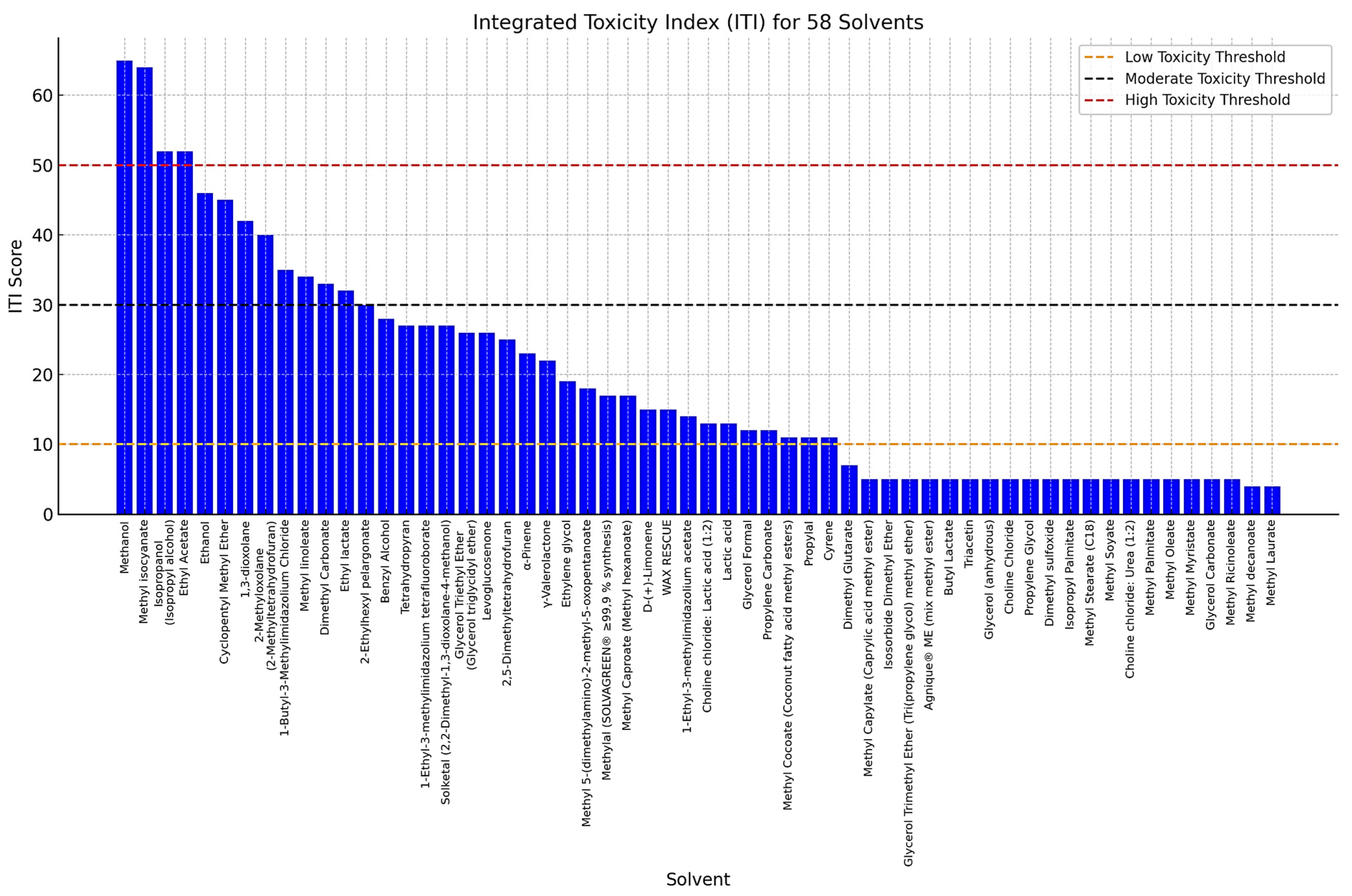

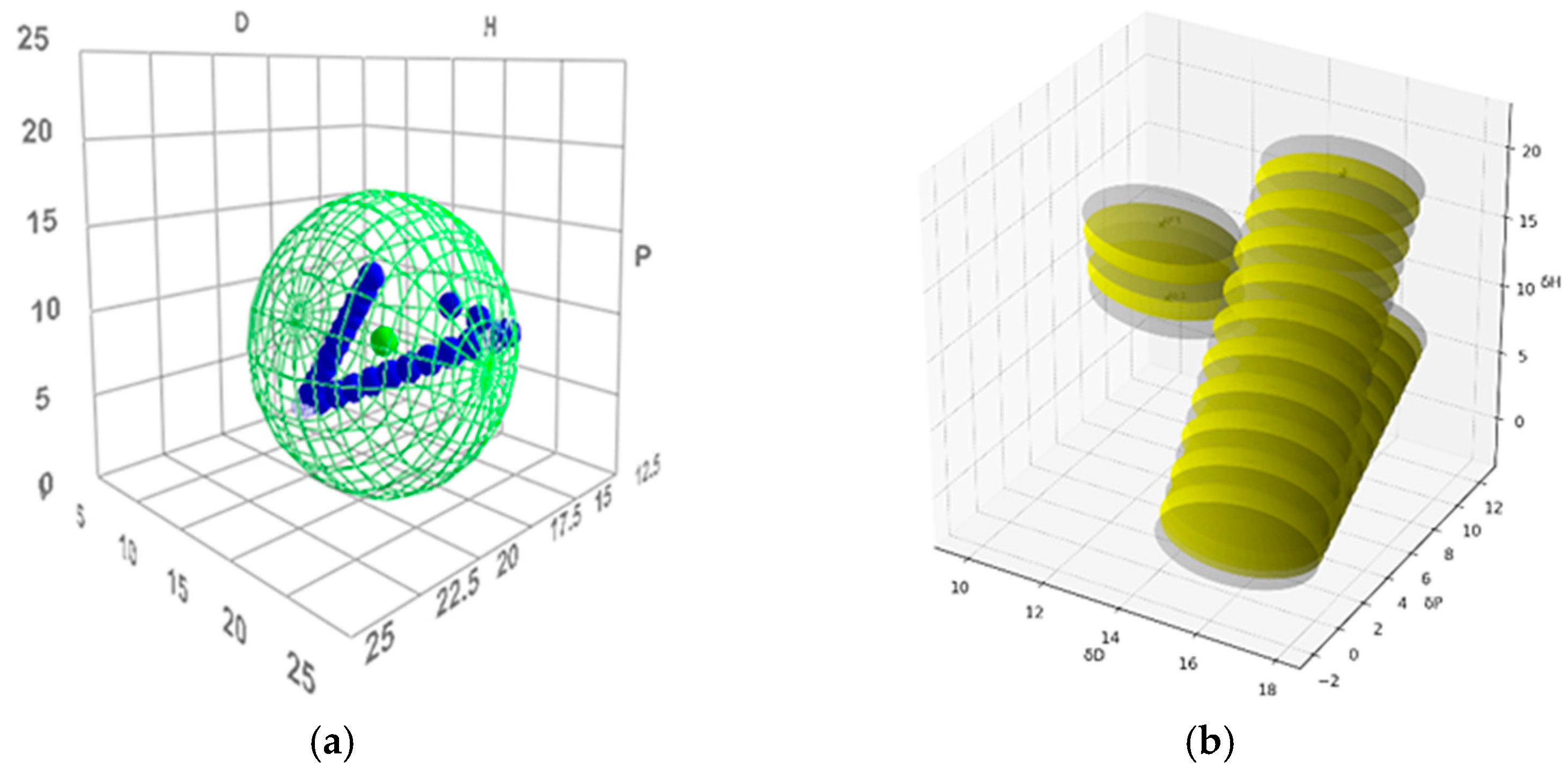
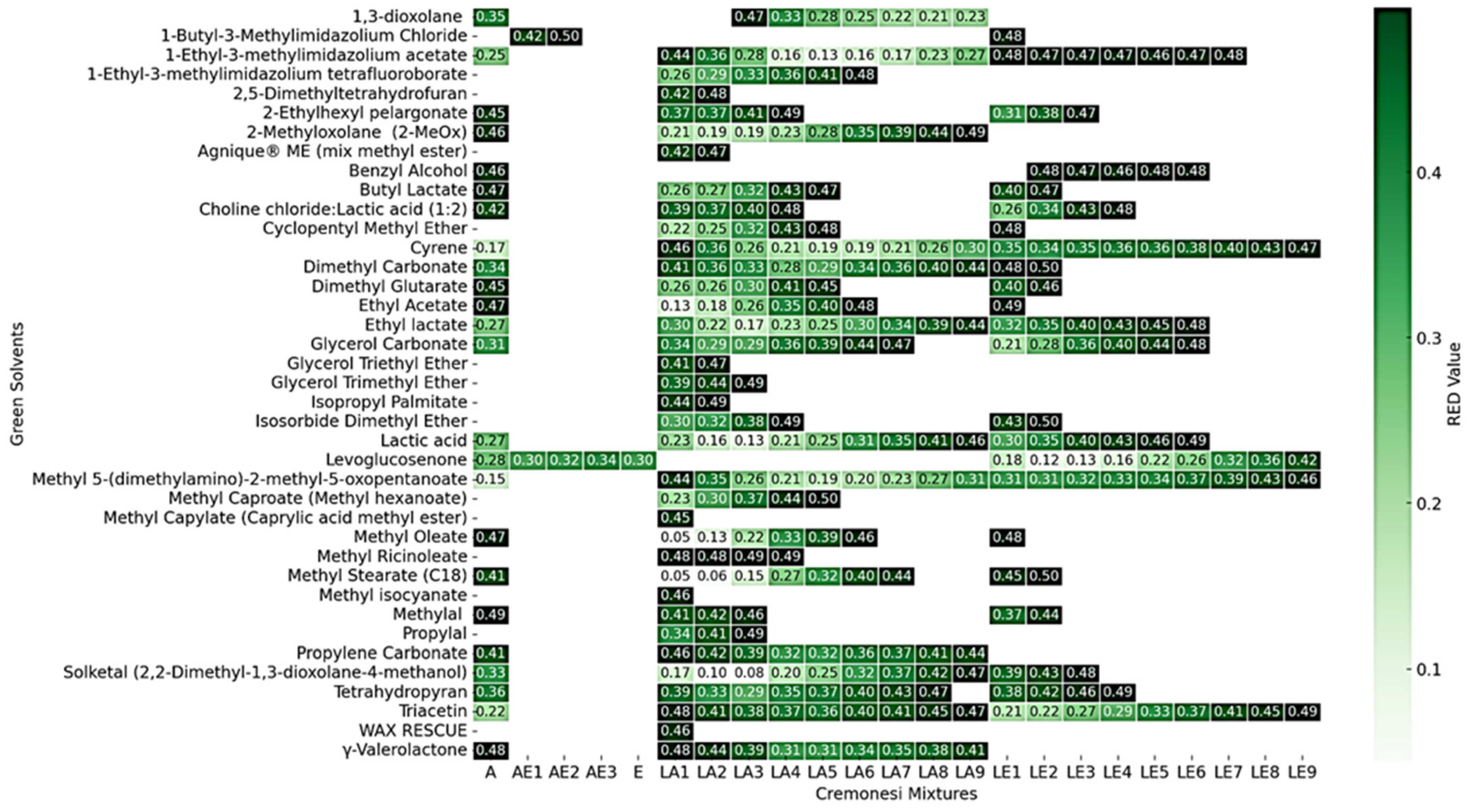
| Category | H-Statement Examples | Weight |
|---|---|---|
| Acute Toxicity 1 | H300, H310, H330 | 10 |
| Acute Toxicity 2 | H301, H311, H331 | 9 |
| Acute Toxicity 3 | H302, H312, H332 | 8 |
| STOT Category 1 | H370, H372 | 9 |
| STOT Category 2 | H371, H373 | 7 |
| Carcinogenicity 1A/B | H350, H340 | 10 |
| Carcinogenicity 2 | H351, H341 | 8 |
| Skin Irritation | H315 | 4 |
| Flammability | H225 | 6 |
| Eye Irritation | H319 | 5 |
| Narcotic Effects | H336 | 7 |
| Category | P-Statement Examples | Weight |
|---|---|---|
| Personal Protection Required | P280 (Wear PPE) | 6 |
| First Aid Response | P301 + P310 (Ingestion hazard) | 8 |
| Proper Disposal Required | P501 (Safe disposal) | 4 |
| Fire Prevention | P210 (Keep away from heat/sparks) | 5 |
| Container Safety | P233 (Keep container tightly closed) | 4 |
| Electrostatic Safety | P240 (Ground/bond container/equipment) | 6 |
| Explosion Protection | P241, P242 (Use explosion-proof equipment) | 6 |
| Eye Wash Procedure | P305 + P351 + P338 (Flush eyes if exposed) | 7 |
| Green Solvents | CAS Number | Chemical Formula | Family | Replaced Solvent | Common Solute O Application | References |
|---|---|---|---|---|---|---|
| 1,3-dioxolane | 646-06-0 | C3H6O2 | Acetals | Acetone | Acrylic resins | [54,55] |
| 1-Butyl-3-Methylimidazolium Chloride | 79917-90-1 | C8H15ClN2 | Ionic Liquids | Dimethylformamide (DMF) | Essential oils Extraction | [51,52,53,54,55] |
| 1-Ethyl-3-methylimidazolium acetate | 143314-17-4 | C8H14N2O2 | Ionic Liquids | Ethylene glycol | Methanol, Ethanol, Water mixtures | [51,52,53,54,55] |
| 1-Ethyl-3-methylimidazolium tetrafluoroborate | 143314-16-3 | C6H11BF4N2 | Ionic Liquids | Chlorinated solvents | Replace Water-Ethanol mixtures | [51,52,53,54,55] |
| 2,5-Dimethyltetrahydrofuran | 1003-38-9 | C6H12O | ethers | Tetrahydrofuran (THF) | Natural product extracts | [32,33,35] |
| 2-Ethylhexyl pelargonate | 59587-44-9 | C17H34O2 | esters | Petroleum-Based Solvents | Oil-based coatings | [19] |
| 2-Methyloxolane (2-MeOx) | 96-47-9 | C5H10O | ethers | n-Hexane | Limonene | [34] |
| Agnique® ME (mix methyl ester) | 85566-26-3 | Fatty acids, C8-10, Me esters | Fatty Acid Methyl Esters (FAME) | White spirit | No polar substances | [18] |
| Benzyl Alcohol | 100-51-6 | C7H8O | Alcohols | Halogenated Solvents | Medium—no polar substances | [2,56] |
| Butyl Lactate | 138-22-7 | C7H14O3 | esters | Acetone, Petroleum-Based Solvents | No polar substances | [28] |
| WAX RESCUE | 2568-90-3 | C9H20O2 | Acetals | Ligroine, white spirit | Regarlez, cristalline and bee waxes | [61,62] |
| Choline Chloride | 67-48-1 | C5H14ClNO | DES | Halogenated Solvents | Thiophenes, Benzothiophenes | [42,43,44,45] |
| Choline chloride: Lactic acid (1:2) | no data | C5H14ClNO-C3H6O3 | DES | Traditional azeotropic solvents | Isopropanol-Water mixtures | [42,43,44,45] |
| Choline chloride: Urea (1:2) | no data | C5H14ClNO-CH4N2O | DES | Conventional DES solvents | Biomolecules | [42,43,44,45] |
| Cyclopentyl Methyl Ether | 5614-37-9 | C6H12O | Ethers | Petroleum-Based Ethers | Natural Product Extracts | [19,20] |
| Cyrene | 53716-82-8 | C6H8O3 | ethers | N-Methyl-2-pyrrolidone (NMP) | Polymers, Cross-coupling reactants | [19,20,64] |
| Dimethyl Carbonate | 616-38-6 | C3H6O3 | Carbonates | Chlorinated solvents | Hydrophobic compounds | [2,63,64,65,66,67,68] |
| Dimethyl Glutarate | 1119-40-0 | C7H12O4 | esters | Petroleum-Based Solvents | Polymer Solutions | [27,28] |
| Dimethyl sulfoxide | 67-68-5 | C2H6OS | Sulfoxide | Chlorinated solvents | Polar compounds | [1,19] |
| Ethanol | 64-17-5 | C2H6O | Alcohols | Acetone | Aged varnishes | [2,27,28] |
| Ethyl lactate | 687-47-8 | C5H10O3 | esters | Acetone, Petroleum-Based Solvents | Natural Extracts | [16,23,24,25,26,27] |
| Glycerol (anhydrous) | 56-81-5 | C3H8O3 | Alcohols | Dimethylformamide (DMF) | High-value bioactive molecules | [57] |
| Glycerol Carbonate | 1379618-83-3 | C13C3H6O4 | Carbonates | Chlorinated Solvents | Hydrophobic Molecules | [57] |
| Glycerol Formal | 99569-11-6 | C8H16O6 | Acetals | Methyl Isobutyl Ketone | Paint and Varnish Components | [57,68] |
| Glycerol Triethyl Ether | 13236-02-7 | C12H20O6 | ethers | Methyl Isobutyl Ketone | Paint and Varnish Components | [57] |
| Glycerol Trimethyl Ether | 25498-49-1 | C10H22O4 | ethers | Methyl Isobutyl Ketone | Paint and Varnish Components | [57] |
| Isopropanol | 67-63-0 | C3H8O | Alcohols | Traditional alcohols | Alcohol-soluble compounds | [27,28] |
| Isopropyl Palmitate | 142-91-6 | C19H38O2 | esters | Ligroin | Protective coatings on metal artifacts | [31] |
| Isosorbide Dimethyl Ether | 5306-85-4 | C8H14O4 | ethers | Traditional Ethers | Polymeric Systems | [19,20] |
| Lactic acid | 50-21-5 | C3H6O3 | organic acid | Petroleum-based esters | Bioactive compounds | [29,30] |
| Levoglucosenone | 37112-31-5 | C6H6O3 | others | Traditional ethers | Natural product extracts | [19,20] |
| Limonene (D-(+)-Limonene) | 5989-27-5 | C₁₀H₁₆ | Terpen | Chlorinated Solvents | Fullerene-based Solar Cells | [65,66,69] |
| Methanol | 67-56-1 | CH4O | Alcohols | Petroleum-based methanol | Alcohol-soluble compounds | [2,19,20] |
| Methyl 5-(dimethylamino)-2-methyl-5-oxopentanoate | 1174627-68-9 | C9H17NO3 | Fatty Acid Methyl Esters (FAME) | Synthetic Solvents | Pharmaceutical Compounds | [18,19,20,21,22] |
| Methyl decanoate | 110-42-9 | C11H22O2 | Fatty Acid Methyl Esters (FAME) | Petroleum-Based Solvents | Microcristalline wax, no polar varnishes | [18,19,20,21,22] |
| Methyl isocyanate | 624-83-9 | C2H3NO | Fatty Acid Methyl Esters (FAME) | Petroleum-Based Solvents | Microcristalline wax, no polar varnishes | [18,19,20,21,22] |
| Methyl Caproate (Methyl hexanoate) | 106-70-7 | C7H14O2 | Fatty Acid Methyl Esters (FAME) | Petroleum-Based Solvents | Microcristalline wax, no polar varnishes | [18,19,20,21,22] |
| Methyl Capylate (Caprylic acid methyl ester) | 111-11-5 | C9H18O2 | Fatty Acid Methyl Esters (FAME) | Petroleum-Based Solvents | Microcristalline wax, no polar varnishes | [18,19,20,21,22] |
| Methyl Cocoate (Coconut fatty acid methyl esters) | 61788-59-8 | C14H28O2 | Fatty Acid Methyl Esters (FAME) | Petroleum-Based Solvents | Microcristalline wax, no polar varnishes | [18,19,20,21,22] |
| Methyl Laurate | 111-82-0 | C13H26O2 | Fatty Acid Methyl Esters (FAME) | Toluene | Microcristalline wax, no polar varnishes | [18,19,20,21,22] |
| Methyl linoleate | 112-63-0 | C19H34O2 | Fatty Acid Methyl Esters (FAME) | Hexane, Toluene | Microcristalline wax, no polar varnishes | [18,19,20,21,22] |
| Methyl Myristate | 124-10-7 | C15H30O2 | Fatty Acid Methyl Esters (FAME) | Petroleum-Based Solvents | Microcristalline wax, no polar varnishes | [18,19,20,21,22] |
| Methyl Oleate | 112-62-9 | C19H36O2 | Fatty Acid Methyl Esters (FAME) | Petroleum-Based Solvents | Microcristalline wax, no polar varnishes | [18,19,20,21,22] |
| Methyl Palmitate | 112-39-0 | CH3(CH2)14CO2CH3 | Fatty Acid Methyl Esters (FAME) | Petroleum-Based Solvents | Microcristalline wax, no polar varnishes | [18,19,20,21,22] |
| Methyl Ricinoleate | 141-24-2 | C19H36O3 | Fatty Acid Methyl Esters (FAME) | Petroleum-Based Solvents | Microcristalline wax, no polar varnishes | [18,19,20,21,22] |
| Methyl Soyate | 67784-80-9 | C19H36O2 | Fatty Acid Methyl Esters (FAME) | White spirits | Microcristalline wax, no polar varnishes | [18,19,20,21,22] |
| Methyl Stearate (C18) | 27234-05-5 | C19H38O2 | Fatty Acid Methyl Esters (FAME) | White spirits | Microcristalline wax, no polar varnishes | [18,19,20,21,22] |
| Methylal | 109-87-5 | C₃H₈O2 | Acetals | Acetone | Synthetic varnishes | [57,58,59,60] |
| Propylal | 505-84-0 | C₇H₁₆O2 | Acetals | Acetone | Synthetic varnishes | [57,58,59,60] |
| Propylene Carbonate | 108-32-7 | C4H6O3 | Carbonates | Chlorinated solvents | Hydrophobic compounds | [2] |
| Propylene Glycol | 57-55-6 | C3H8O2 | Alcohols | Ethanol | Active Pharmaceutical Ingredients | [2,19,20] |
| Solketal (2,2-Dimethyl-1,3-dioxolane-4-methanol) | 100-79-8 | C6H12O3 | Acetals | Acetone, Ethanol | Varnishes, Film-forming layers | [17] |
| Tetrahydropyran | 142-68-7 | C5H10O | ethers | Tetrahydrofuran (THF) | Natural product extracts | [33,34] |
| Triacetin | 102-76-1 | C9H14O6 | Glycerol Derivatives | Acetone, Alcohols | Synthetic varnishes | [57] |
| α-Pinene | 80-56-8 | C10H16 | Terpen | n-Hexane | No polar varnishes | [49] |
| γ-Valerolactone | 108-29-2 | C5H8O2 | Esters | Tetrahydrofuran (THF) | Hydrophobic compounds | [2,19,32] |
| Ethyl Acetate | 141-78-6 | C4H8O2 | Esters | Acetone, Alcohols | Medium polar substances | [2,36] |
| Ethylene glycol (1,2-Ethanediol) | 107-21-1 | C2H6O2 | Alcohols | Water, Acetone | Polar substances | [2,19,20] |
| Green Solvents | δD (Dispersion) | δP (Polar) | δH (Hydrogen Bonding) | δT (Hansen Total Solubility Parameter) |
|---|---|---|---|---|
| 1,3-dioxolane | 18.1 | 6.6 | 9.3 | 21.4 |
| 1-Butyl-3-Methylimidazolium Chloride | 13.4 | 8.2 | 9.6 | 18.4 |
| 1-Ethyl-3-methylimidazolium acetate | 17.3 | 6.8 | 8.7 | 20.5 |
| 1-Ethyl-3-methylimidazolium tetrafluoroborate | 16.5 | 4.2 | 7 | 18.4 |
| 2,5-Dimethyltetrahydrofuran | 15.8 | 2.8 | 5.7 | 17.0 |
| 2-Ethylhexyl pelargonate | 14.9 | 6.8 | 8.3 | 18.4 |
| 2-Methyloxolane (2-MeOx) | 16.8 | 5.7 | 6.2 | 18.8 |
| Agnique® ME (mix methyl ester) | 16.4 | 3.3 | 4.7 | 17.4 |
| Benzyl Alcohol | 16 | 6.3 | 13 | 21.6 |
| Butyl Lactate | 15.2 | 7.3 | 6.4 | 18.0 |
| WAX RESCUE | 14.7 | 3.43 | 5.9 | 16.2 |
| Choline Chloride | 17 | 15.5 | 21.2 | 31.3 |
| Choline chloride:Lactic acid (1:2) | 14.9 | 7.5 | 8.1 | 18.5 |
| Choline chloride:Urea (1:2) | 14.5 | 5.9 | 18 | 23.9 |
| Cyclopentyl Methyl Ether | 15.3 | 6.8 | 5.8 | 17.7 |
| Cyrene | 16.8 | 9 | 7.8 | 20.6 |
| Dimethyl Carbonate | 16.8 | 5.5 | 9.3 | 20.0 |
| Dimethyl Glutarate | 15.3 | 7.5 | 6.3 | 18.2 |
| Dimethyl sulfoxide | 18.4 | 16.4 | 10.2 | 26.7 |
| Ethanol | 15.8 | 8.8 | 19.4 | 26.5 |
| Ethyl lactate | 16.2 | 8.3 | 7.1 | 19.5 |
| Glycerol (anhydrous) | 10.8 | 2.5 | 9.3 | 14.5 |
| Glycerol Carbonate | 15.5 | 8.2 | 7.8 | 19.2 |
| Glycerol Formal | 16.37 | 11.99 | 19.63 | 28.2 |
| Glycerol Triethyl Ether | 15.5 | 4.8 | 3.6 | 16.6 |
| Glycerol Trimethyl Ether | 15.5 | 5.7 | 3.6 | 16.9 |
| Isopropanol | 15.8 | 9.5 | 17.4 | 25.4 |
| Isopropyl Palmitate | 16.2 | 3.9 | 3.7 | 17.1 |
| Isosorbide Dimethyl Ether | 14.9 | 6.9 | 6.5 | 17.7 |
| Lactic acid | 16.1 | 7.5 | 7.6 | 19.3 |
| Levoglucosenone | 15.6 | 9.2 | 11.1 | 21.2 |
| Limonene | 17.2 | 1.8 | 4.3 | 17.8 |
| Methanol | 15.1 | 12.3 | 22.3 | 29.6 |
| Methyl 5-(dimethylamino)-2-methyl-5-oxopentanoate | 16.7 | 8.9 | 8 | 20.5 |
| Methyl decanoate | 14.8 | 2.7 | 4.5 | 15.7 |
| Methyl isocyanate | 15.9 | 2.4 | 5.7 | 17.1 |
| Methyl Caproate | 16 | 4.3 | 5.8 | 17.6 |
| Methyl Capylate | 15.4 | 2.7 | 5.9 | 16.4 |
| Methyl Cocoate | 16 | 2 | 5 | 16.9 |
| Methyl Laurate | 16 | 2.1 | 5.2 | 17.0 |
| Methyl linoleate | 16.2 | 1.7 | 4.2 | 16.8 |
| Methyl Myristate | 16 | 1.9 | 4.2 | 16.7 |
| Methyl Oleate | 15.8 | 5.9 | 6.5 | 18.1 |
| Methyl Palmitate | 16 | 1.6 | 3.6 | 16.5 |
| Methyl Ricinoleate | 16.4 | 3.5 | 9.3 | 19.2 |
| Methyl Soyate | 16.1 | 1.6 | 3.8 | 16.6 |
| Methyl Stearate (C18) | 16 | 6.2 | 6.8 | 18.5 |
| Methylal | 14.83 | 6.01 | 8.76 | 18.2 |
| Propylal | 15.11 | 3.95 | 6.32 | 16.8 |
| Propylene Carbonate | 17.2 | 4.9 | 9.1 | 20.1 |
| Propylene Glycol | 17 | 12 | 26 | 33.3 |
| Solketal (2,2-Dimethyl-1,3-dioxolane-4-methanol) | 16.2 | 7.3 | 6.8 | 19.0 |
| Tetrahydropyran | 16 | 9.1 | 6.2 | 19.4 |
| Triacetin | 16 | 7.5 | 10 | 20.3 |
| α-Pinene | 16 | 2.1 | 1.9 | 16.2 |
| γ-Valerolactone | 17.8 | 5 | 7.4 | 19.9 |
| Ethyl Acetate | 15.8 | 5.3 | 7.2 | 18.2 |
| Ethylene glycol (1,2-Ethanediol) | 7 | 11 | 26 | 29.1 |
| Solvent | H-Statements | P-Statements | LD50 (Oral, Rat) (mg/kg) | ITI Score | Toxicity Classification |
|---|---|---|---|---|---|
| Water | None | None | Not applicable | 0 | Non-toxic |
| Acetone | H225 H319 H336 | P210 P233 P240 P241 P242 P243 P305 + P351 + P338 | 5800 | 52 | Toxic |
| Ethanol | H225 H319 H371 | P210 P233 P240 P241 P305 + P351 + P338 P308 + P311 | 10,470 | 46 | Harmful |
| Ligroin | H224 H304 H315 H336 H411 | P210 P273 P273 P301 + P310 P331 P403 + P233 | >5000 | 66 | Highly Toxic |
| Toluene | H225 H304 H315 H336 H361d H373 H412 | P202 P210 P273 P301 + P310 P331 P303 + P361 + P353 | 5580 | 79 | Highly Toxic |
| Xylene | H226 H315 H319 H312 H332 H335 H373 H304 H412 | P210 P273 P280 P301 + P310 P303 + P361 + P353 P331 | 3523 | 87 | Extremely Toxic |
| Methanol | H225 H301 H331 H370 | P210 P233 P280 P301 + P310 P303 + P361 + P353 P304 + P340 + P311 | 100.1 | 56 | Toxic |
| Solvent | ITI Score | ITI Toxicity Category | HSP Score | HSP Predicted Toxicity |
|---|---|---|---|---|
| Water | 0 | Non-toxic | 0 | Non-toxic |
| Acetone | 52 | Toxic | 0 | Low Toxicity |
| Ethanol | 46 | Harmful | 0 | Low Toxicity |
| Ligroin | 66 | Highly Toxic | 2 | Moderately Toxic |
| Toluene | 79 | Highly Toxic | 3 | Highly Toxic |
| Xylene | 87 | Extremely Toxic | 3 | Moderately Toxic |
| Methanol | 56 | Toxic | Unclassified (UC) | Extremely Toxic |
| Ligroin | Ethanol | Acetone |
|---|---|---|
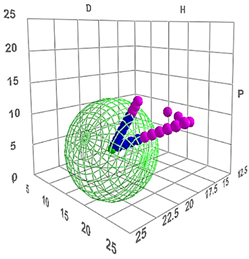 | 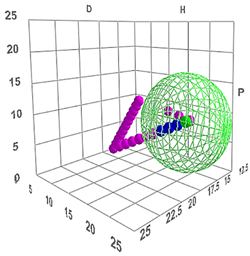 | 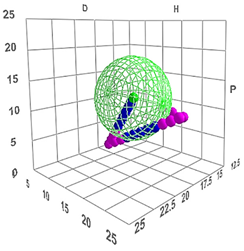 |
| Ligroin (%) | Acetone (%) | Ethanol (%) | δD | δP | δH | Fd | Fp | Fh | |
|---|---|---|---|---|---|---|---|---|---|
| L100A0 | 100 | 0 | 0 | 16.0 | 0.0 | 0.0 | 100.0 | 0.0 | 0.0 |
| L75A25 | 75 | 25 | 0 | 15.9 | 2.6 | 1.8 | 85.0 | 8.5 | 6.5 |
| L50A50 | 50 | 50 | 0 | 15.8 | 5.2 | 3.5 | 70.0 | 17.5 | 12.5 |
| L25A75 | 25 | 75 | 0 | 15.7 | 7.8 | 5.3 | 55.0 | 26.5 | 18.5 |
| L0A100 | 0 | 100 | 0 | 15.5 | 10.4 | 7.0 | 40.0 | 35.0 | 25.0 |
| A75E25 | 0 | 75 | 25 | 15.5 | 9.5 | 9.9 | 34.0 | 33.0 | 33.0 |
| A50E50 | 0 | 50 | 50 | 15.6 | 8.5 | 12.9 | 30.0 | 28.0 | 42.0 |
| A25E75 | 0 | 25 | 75 | 15.7 | 7.6 | 15.8 | 25.0 | 24.0 | 51.0 |
| A0E100 | 0 | 0 | 100 | 15.8 | 8.8 | 19.4 | 20.0 | 22.0 | 58.0 |
| L50A25E25 | 50 | 25 | 25 | 15.9 | 2.8 | 5.2 | 70.0 | 10.0 | 20.0 |
| L25A50E25 | 25 | 50 | 25 | 15.8 | 5.3 | 7.8 | 55.0 | 17.5 | 27.5 |
| L25A25E50 | 25 | 25 | 50 | 15.7 | 4.1 | 9.3 | 45.0 | 12.0 | 43.0 |
| L33A33E33 | 33 | 33 | 33 | 15.8 | 4.6 | 8.4 | 55.0 | 15.0 | 30.0 |
| ID | Ligroin (%) | MEK (%) | Ethanol (%) | Fd | Fp | Fh |
|---|---|---|---|---|---|---|
| L | 100 | 0 | 0 | 97 | 2 | 1 |
| LM1 | 90 | 10 | 0 | 92 | 5 | 3 |
| LM2 | 80 | 20 | 0 | 87 | 8 | 5 |
| LM3 | 70 | 30 | 0 | 82 | 11 | 7 |
| LM4 | 60 | 40 | 0 | 77 | 14 | 9 |
| LM5 | 50 | 50 | 0 | 72 | 17 | 11 |
| LM6 | 40 | 60 | 0 | 67 | 20 | 13 |
| LM7 | 30 | 70 | 0 | 62 | 23 | 15 |
| LM8 | 20 | 80 | 0 | 57 | 26 | 17 |
| LM9 | 10 | 90 | 0 | 52 | 29 | 19 |
| M | 0 | 100 | 0 | 47 | 32 | 21 |
| LME1 | 90 | 0 | 10 | 91 | 4 | 5 |
| LME2 | 80 | 0 | 20 | 85 | 5 | 10 |
| LME3 | 70 | 0 | 30 | 79 | 7 | 14 |
| LME4 | 60 | 0 | 40 | 73 | 8 | 19 |
| LME5 | 50 | 0 | 50 | 67 | 10 | 23 |
| LME6 | 40 | 0 | 60 | 60 | 12 | 28 |
| LME7 | 30 | 0 | 70 | 54 | 13 | 33 |
| LME8 | 20 | 0 | 80 | 48 | 15 | 37 |
| LME9 | 10 | 0 | 90 | 42 | 16 | 42 |
| E | 0 | 0 | 100 | 36 | 18 | 46 |
| ME1 | 0 | 75 | 25 | 44 | 29 | 27 |
| ME2 | 0 | 50 | 50 | 42 | 25 | 33 |
| ME3 | 0 | 25 | 75 | 39 | 21 | 40 |
| ID | Ligroin (%) | MEK (%) | Ethanol (%) | δD | δP | δH |
|---|---|---|---|---|---|---|
| L100M0 | 100 | 0 | 0 | 16.0 | 0.0 | 0.0 |
| LM1 | 75 | 25 | 0 | 15.9 | 2.6 | 1.8 |
| LM2 | 50 | 50 | 0 | 15.8 | 5.2 | 3.5 |
| L25M75 | 25 | 75 | 0 | 15.7 | 7.8 | 5.3 |
| L0M100 | 0 | 100 | 0 | 15.5 | 10.4 | 7.0 |
| M75E25 | 0 | 75 | 25 | 15.6 | 9.2 | 9.8 |
| M50E50 | 0 | 50 | 50 | 15.7 | 8.1 | 12.7 |
| M25E75 | 0 | 25 | 75 | 15.8 | 7.1 | 15.6 |
| M0E100 | 0 | 0 | 100 | 15.8 | 8.8 | 19.4 |
| L50M25E25 | 50 | 25 | 25 | 15.9 | 2.8 | 5.2 |
| L25M50E25 | 25 | 50 | 25 | 15.8 | 5.3 | 7.8 |
| L25M25E50 | 25 | 25 | 50 | 15.7 | 4.1 | 9.3 |
| L33M33E33 | 33 | 33 | 33 | 15.8 | 4.6 | 8.4 |
| LA1 | LE1 | AE1 |
|---|---|---|
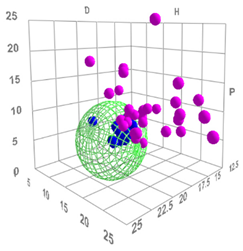 | 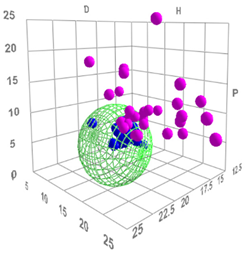 | 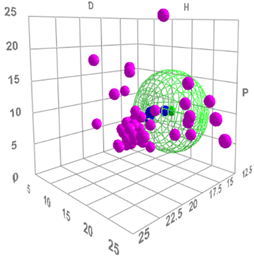 |
Disclaimer/Publisher’s Note: The statements, opinions and data contained in all publications are solely those of the individual author(s) and contributor(s) and not of MDPI and/or the editor(s). MDPI and/or the editor(s) disclaim responsibility for any injury to people or property resulting from any ideas, methods, instructions or products referred to in the content. |
© 2025 by the authors. Licensee MDPI, Basel, Switzerland. This article is an open access article distributed under the terms and conditions of the Creative Commons Attribution (CC BY) license (https://creativecommons.org/licenses/by/4.0/).
Share and Cite
Macchia, A.; Valentini, F.; Colasanti, I.A.; Zaratti, C. Prediction of Green Solvent Applicability in Cultural Heritage Using Hansen Solubility Parameters, Cremonesi Method and Integrated Toxicity Index. Sustainability 2025, 17, 2944. https://doi.org/10.3390/su17072944
Macchia A, Valentini F, Colasanti IA, Zaratti C. Prediction of Green Solvent Applicability in Cultural Heritage Using Hansen Solubility Parameters, Cremonesi Method and Integrated Toxicity Index. Sustainability. 2025; 17(7):2944. https://doi.org/10.3390/su17072944
Chicago/Turabian StyleMacchia, Andrea, Federica Valentini, Irene Angela Colasanti, and Camilla Zaratti. 2025. "Prediction of Green Solvent Applicability in Cultural Heritage Using Hansen Solubility Parameters, Cremonesi Method and Integrated Toxicity Index" Sustainability 17, no. 7: 2944. https://doi.org/10.3390/su17072944
APA StyleMacchia, A., Valentini, F., Colasanti, I. A., & Zaratti, C. (2025). Prediction of Green Solvent Applicability in Cultural Heritage Using Hansen Solubility Parameters, Cremonesi Method and Integrated Toxicity Index. Sustainability, 17(7), 2944. https://doi.org/10.3390/su17072944








